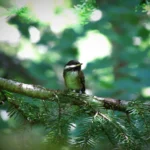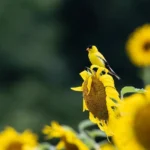In the world of avian wonders, few sights are as captivating as the elegant contrast of black birds with a white belly. These striking creatures, with their dark plumage and snowy undersides, present a beautiful paradox that captures the imagination of bird enthusiasts and casual observers alike.
Whether darting through dense forests, gracing suburban gardens, or soaring across open fields, these birds never fail to leave a lasting impression.
From their unique habitats and varied diets to fascinating facts that highlight their distinctive behaviors, these birds offer a glimpse into the diverse and intricate world of our feathered friends.
Prepare to be enchanted by their beauty, intrigued by their habits, and inspired by the stories they have to tell.
Black Birds With a White Belly
1. Black-and-White Warbler (Mniotilta varia)

Meet the Black-and-White Warbler, a favorite among beginner bird watchers for its striking appearance and easy-to-recognize behavior. This charming bird, once called the ‘Black-and-white Creeper,’ loves to climb tree trunks and branches like a nuthatch, making it a joy to observe as it hunts for insects in bark crevices.
Unlike other warblers, the Black-and-White Warbler often feeds low and nests even lower, usually right on the ground. This unique habit makes it an intriguing sight in northern and eastern North America during the breeding season. When winter arrives, you can find these birds in Florida, Central America, and even the West Indies.
Despite its broad range, the Black-and-White Warbler remains a delightful discovery for bird enthusiasts.
Its bold black-and-white stripes and distinctive foraging style make it a standout in any bird-watching adventure. So, keep an eye out for this fascinating little warbler the next time you’re exploring the great outdoors!

2. Black Phoebe (Sayornis Nigricans)

Say hello to the Black Phoebe, a charming bird with a sleek, dark charcoal gray body and a crisp white belly. This petite bird, easily recognizable by its slim shape and upright posture, often perches near water, dipping its tail up and down as if in a cheerful nod.
One of the endearing habits of the Black Phoebe is its frequent short flights to catch insects mid-air, making it a lively and entertaining bird to watch. Juvenile Black Phoebes sport rusty edges on their wing and back feathers, adding a touch of color to their otherwise monochromatic appearance.
The Black Phoebe’s life cycle is quite fascinating. Females lay 3-6 eggs, which they incubate for about 15-17 days. Both parents diligently feed the nestlings until they are ready to leave the nest, usually after 2-3 weeks.
These resilient birds can live up to 8 years, bringing joy to bird watchers with their energetic antics and striking look. Keep an eye out for these delightful birds on your next nature walk.
Also read: Types of Yellow Birds in Michigan
3. White-collared Blackbird (Turdus albocinctus)

Dibyendu Ash, CC BY-SA 3.0, via Wikimedia Commons
Meet the White-collared Blackbird, a captivating bird native to the Indian subcontinent. You’ll find these striking birds in the lush, subtropical montane forests and high-altitude shrublands of Bangladesh, Bhutan, India, Myanmar, Nepal, and Pakistan.
With their distinctive white collar and dark plumage, they are a delight to spot.
One fascinating aspect of the White-collared Blackbird is its unique breeding behavior, especially on the Tibetan Plateau. Here, these birds can breed twice a year. The first breeding cycle usually results in smaller clutches with fewer, but healthier, chicks.
The second attempt, often larger, produces more chicks, although they tend to be in lower body condition.
This variation is thought to be influenced by changes in food availability and parental feeding behaviors throughout the seasons.
Interestingly, field studies have shown that female White-collared Blackbirds display different nest defense behaviors, classified into bold and shy personalities.
Bold females tend to have higher nest success rates compared to their shy counterparts. These birds feed their chicks a diet rich in plant material, especially berries, along with invertebrates like arthropods and annelids.
4. Pied Wagtail

Pied Wagtail, is a small and charming bird that is a delight to watch with its distinctive behavior and striking appearance. Known for its characteristic tail-wagging, this little bird belongs to the family Motacillidae, which also includes pipits and long claws.
The Pied Wagtail, a subspecies of the White Wagtail, is predominantly found in Ireland and Great Britain. These birds are often seen in a variety of habitats, including beaches, meadows, and stream sides, where they forage for insects and other small invertebrates. Their bold black and white plumage makes them easy to spot as they flit about, wagging their tails up and down incessantly.
One of the charming habits of the Pied Wagtail is its preference for nesting on the ground while choosing trees for roosting. This dual habitat use makes them quite adaptable and interesting to observe. Despite their small size, Pied Wagtails are lively and active, adding a touch of cheerfulness to any landscape.
With their playful tail movements and striking looks, Pied Wagtails are sure to bring a smile to your face. So, next time you’re near a beach, meadow, or stream, keep an eye out for these delightful birds and enjoy their lively antics!
5. Eastern Kingbird (Tyrannus tyrannus)

Eastern Kingbird, is a striking and bold bird that is a delight to observe. This large tyrant flycatcher is native to the Americas and is easily recognizable by its dark gray upperparts and contrasting white underbelly.
Eastern Kingbirds are commonly found in open areas with scattered trees and bushes, where they perch conspicuously while foraging for insects. These birds are not shy; their scientific name, Tyrannus, means “tyrant” or “king,” a nod to their aggressive behavior. Eastern Kingbirds are known to fiercely defend their nests, even taking on much larger predators like hawks, crows, and squirrels.
During the breeding season, these birds are highly territorial and primarily feed on flying insects. However, their diet shifts in the winter when they migrate to South America, where they travel in flocks and feast on fruits. The Eastern Kingbird’s adaptability and boldness make it a fascinating subject for bird watchers.
With a lifespan of up to 10 years in the wild, the Eastern Kingbird continues to captivate with its striking appearance and fearless nature. Next time you’re in an open field or near a grove of trees, keep an eye out for this regal bird and enjoy its commanding presence!
6. Magpie-lark (Grallina cyanoleuca)

Nigel Jacques (Kris)., CC BY-SA 2.5, via Wikimedia Commons
Magpie-lark is a delightful and highly intelligent bird native to Australia and New Guinea. Known for its striking black-and-white plumage, the Magpie-lark is a member of the monarch flycatcher family and brings a touch of elegance to any landscape it graces.
These birds are not only beautiful but also fascinating in their behavior. Magpie larks are renowned for their intelligence and strong family bonds. They are often seen singing cheerful songs, which are a joy to hear and add a lively soundtrack to their surroundings. Their uplifting birdsongs and friendly demeanor make them a favorite among bird watchers and nature lovers.
Magpie larks are known for their unique behaviors related to reflection and mirroring, often seen engaging in acts of self-preoccupation and complimenting others.
They have a remarkable ability to recognize themselves in mirrors, a trait shared with very few animals. Their social nature involves a balance of give and take, making them a symbol of cooperation and community.
These birds are also fiercely protective of their territory and family, demonstrating a blend of aggression and caring that ensures their space and resources are well-guarded.
7. Willy Wagtail (Rhipidura leucophrys)

Willy Wagtail is a lively and charming bird native to Australia. Known for its energetic behavior and distinctive black-and-white plumage, the Willy Wagtail is a favorite among bird enthusiasts.
In Indigenous Australian culture, the Willy Wagtail is a bird with a personality. It’s believed to be a gossiper, eavesdropping around camps and even telling the spirits if anyone spoke ill of the deceased. This fascinating folklore adds a layer of mystique to this already captivating bird.
Willy Wagtails are active feeders and can often be seen darting around lawns, wagging their tails from side to side as they hunt for insects on the ground. They are adept hunters, catching beetles, larvae, flies, spiders, wasps, bees, ants, and grasshoppers both from perches and in mid-air chases. Their constant movement and cheerful tail-wagging make them a delight to watch.
These birds are not just about looks and lore; they play a crucial role in controlling insect populations, making them beneficial for gardens and parks. Their friendly and approachable nature, coupled with their tireless hunting, makes the Willy Wagtail a bird worth admiring.
8. Black-and-White Flycatcher (Ficedula hypoleuca)

Aviceda, CC BY-SA 3.0, via Wikimedia Commons
The Black-and-White Flycatcher is a delightful bird that adds a touch of elegance to the forests and woodlands of Europe and Western Asia. With its striking black and white plumage, this small passerine is a joy to observe. Males sport a sleek black upper body with a contrasting white belly, while females are more subdued with brownish-gray upperparts and a paler underside.
Black-and-White Flycatchers are skilled hunters, catching insects in mid-air with acrobatic precision. They are often seen flitting about the forest canopy or perched on branches, scanning for their next meal. During the breeding season, they become highly territorial, fiercely defending their nesting sites from intruders.
These birds have a fascinating migration pattern. They breed in Europe and Western Asia, then migrate to sub-Saharan Africa for the winter. This long journey showcases their incredible endurance and adaptability. Whether you’re a seasoned bird watcher or a casual nature lover, spotting a Black-and-White Flycatcher is always a delightful experience.
9. Common Blackbird (Turdus merula)

The Common Blackbird is a familiar sight across Europe, Asia, and North Africa, known for its melodious song and striking appearance. Males are easily recognizable with their glossy black feathers and bright orange-yellow beak, while females are more subdued with brownish plumage and a slightly speckled breast.
These adaptable birds thrive in a variety of habitats, from dense forests to urban gardens. They are often seen hopping along the ground, foraging for insects, worms, and berries. Their diet changes with the seasons, reflecting their ability to make the most of their environment.
Common Blackbirds are also known for their enchanting song, which can be heard at dawn and dusk, adding a lovely soundtrack to the start and end of the day. During the breeding season, these birds become quite territorial, using their song to defend their area and attract mates.
10. Ring Ouzel (Turdus torquatus)

The Ring Ouzel is a striking bird, easily recognized by its black plumage and distinctive white crescent on its chest.
Predominantly an upland bird, the Ring Ouzel breeds in steep-sided valleys, crags, and gullies across the UK, from sea level in northern Scotland to the high Cairngorms.
In the UK, between 6,200 and 7,500 pairs of Ring Ouzels breed annually. However, their population is on a worrying decline, having decreased by 43% over the last 40 years, placing them on the Red List of high conservation concern.
The Ring Ouzel’s song is hauntingly beautiful, reminiscent of a melancholic telephone ringing out over the moorlands. This evocative sound adds to the bird’s mysterious allure, making it a special sighting for bird watchers. Despite their current struggles, the Ring Ouzel remains a symbol of the wild, rugged landscapes they inhabit.
So wrapping it up with These top 10 blackbirds with a white belly!

Welcome to World Birds Life, where the wonder of birds takes center stage. My name is Lexi, and I’m passionate about helping you discover the beauty and joy that birds bring into our lives.







